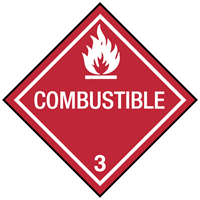
 Print
Print
Chemical Datasheet
ETHANOL, 1,2-DICHLORO-, ACETATE |

|
Chemical Identifiers
| CAS Number |
UN/NA Number |
DOT Hazard Label |
USCG CHRIS Code |
- 10140-87-1

|
|
|
none
|
| NIOSH Pocket Guide |
International Chem Safety Card |
|
none
|
none
|
NFPA 704
data unavailable
General Description
Water-white liquid. Density 1.23 g / cm3. Flash point 307°F. Low toxicity. Miscible with alcohol and ethyl ether. Insoluble in water. Used in organic synthesis.
Hazards
Reactivity Alerts
none
Air & Water Reactions
Insoluble in water.
Fire Hazard
May be ignited by heat, sparks or flames. Vapors may travel to a source of ignition and flash back. Container may explode in heat of fire. Vapor explosion hazard indoors, outdoors or in sewers. Runoff to sewer may create fire or explosion hazard. When heated to decomposition, it may emit highly toxic fumes of phosgene. Esters may explode on mixing with nitrates. (EPA, 1998)
Health Hazard
This material is toxic by inhalation. (EPA, 1998)
Reactivity Profile
ETHANOL, 1,2-DICHLORO-, ACETATE is a halogenated ester. React with acids to liberate heat along with alcohols and acids. Strong oxidizing acids may cause a vigorous reaction that is sufficiently exothermic to ignite the reaction products. Heat is also generated by interaction with caustic solutions. Flammable hydrogen is generated by mixing with alkali metals and hydrides.
Belongs to the Following Reactive Group(s)
- Esters, Sulfate Esters, Phosphate Esters, Thiophosphate Esters, and Borate Esters
- Halogenated Organic Compounds
Potentially Incompatible Absorbents
No information available.
Response Recommendations
Isolation and Evacuation
Excerpt from ERG Guide 128 [Flammable Liquids (Water-Immiscible)]:
IMMEDIATE PRECAUTIONARY MEASURE: Isolate spill or leak area for at least 50 meters (150 feet) in all directions.
LARGE SPILL: Consider initial downwind evacuation for at least 300 meters (1000 feet).
FIRE: If tank, rail tank car or highway tank is involved in a fire, ISOLATE for 800 meters (1/2 mile) in all directions; also, consider initial evacuation for 800 meters (1/2 mile) in all directions. (ERG, 2024)
Firefighting
Move container from fire area if you can do it without risk. Cool containers that are exposed to flames with water from the side until well after fire is out. For massive fire in cargo area, use unmanned hose holder or monitor nozzles; if this is impossible, withdraw from area and let fire burn. Withdraw immediately in case of rising sound from venting safety device or any discoloration of tank due to fire. Wear self-contained (positive pressure if available) breathing apparatus and full protective clothing. Isolate one-half mile in all directions if tank car or truck is involved in fire.
To extinguish small fires: dry chemical, carbon dioxide, water spray or foam. Large fires: water spray, fog or foam. (EPA, 1998)
Non-Fire Response
Keep unnecessary people away; isolate hazard area and deny entry. Stay upwind; keep out of low areas. Shut off ignition sources; no flares, smoking or flames in hazard area. Stop leak if you can do it without risk. Use water spray to reduce vapors.
Small spills: take up with sand or other non-combustible absorbent material and place into containers for later disposal.
Large spills: dike far ahead of spill for later disposal. (EPA, 1998)
Protective Clothing
For emergency situations, wear a positive pressure, pressure-demand, full facepiece self-contained breathing apparatus (SCBA) or pressure- demand supplied air respirator with escape SCBA and a fully-encapsulating, chemical resistant suit. (EPA, 1998)
DuPont Tychem® Suit Fabrics
No information available.
First Aid
Inhalation is a route of entry.Move victim to fresh air; call emergency medical care. If not breathing, give artificial respiration. If breathing is difficult, give oxygen. In case of contact with material, immediately flush eyes with running water for at least 15 minutes. Wash skin with soap and water. Remove and isolate contaminated clothing and shoes at the site. (EPA, 1998)
Physical Properties
Flash Point:
307°F
(EPA, 1998)
Lower Explosive Limit (LEL):
Combustible.
(EPA, 1998)
Upper Explosive Limit (UEL):
Combustible.
(EPA, 1998)
Autoignition Temperature: data unavailable
Melting Point:
Less than -26°F
(EPA, 1998)
Vapor Pressure: data unavailable
Vapor Density (Relative to Air): data unavailable
Specific Gravity:
1.296
at 68°F
(EPA, 1998)
- Denser than water; will sink
Boiling Point:
136 to 149°F
at 13 mmHg
(EPA, 1998)
Molecular Weight:
157
(EPA, 1998)
Water Solubility: data unavailable
Ionization Energy/Potential: data unavailable
IDLH: data unavailable
AEGLs (Acute Exposure Guideline Levels)
No AEGL information available.
ERPGs (Emergency Response Planning Guidelines)
No ERPG information available.
PACs (Protective Action Criteria)
| Chemical |
PAC-1 |
PAC-2 |
PAC-3 |
| Dichloroethanol acetate, 1,2- (10140-87-1)
|
0.15 ppm |
1.7 ppm |
10 ppm |
(DOE, 2024)
Regulatory Information
EPA Consolidated List of Lists
| Regulatory Name |
CAS Number/
313 Category Code |
EPCRA 302
EHS TPQ |
EPCRA 304
EHS RQ |
CERCLA RQ |
EPCRA 313
TRI |
RCRA
Code |
CAA 112(r)
RMP TQ |
| Ethanol, 1,2-dichloro-, acetate |
10140-87-1 |
1000 pounds |
1000 pounds |
|
|
|
|
(EPA List of Lists, 2024)
CISA Chemical Facility Anti-Terrorism Standards (CFATS)
No regulatory information available.
OSHA Process Safety Management (PSM) Standard List
No regulatory information available.
Alternate Chemical Names
- 1,2-DICHLOROETHYL ACETATE
- ETHANOL, 1,2-DICHLORO-, ACETATE


 Print
Print
